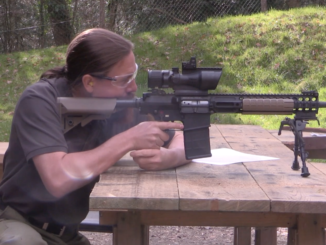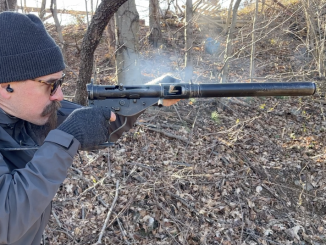After the British adopted the FAL as the L1A1 rifle, there was still an interest in converting stocks of existing No4 Enfield rifles to the new 7.62x51mm cartridge for reserve and training use. A conversion system was developed using a new barrel, bolt, and magazine – although the Sterling company was doing much the same thing at the same time and intellectual property lawsuits would close the project for nearly 10 years. By the time the lawsuits cleared up, it had become clear that the rifles were neither particularly successful nor particularly necessary anymore. The problem the British has was one of accuracy – the 7.62mm version just wasn’t sufficiently accurate. A thousand were sold to Sierra Leone, and a few more used in New Zealand and by cadet organizations in the UK, but the project was basically a failure.
Related Articles

Semiauto Rifles
British L129A1 Sharpshooter Rifle
Armament Research Services (ARES) is a specialist technical intelligence consultancy, offering expertise and analysis to a range of government and non-government entities in the arms and munitions field. For detailed photos of the guns in […]

Submachine Guns
Prototype Silenced Sten Mk4(S) at the Range
Yesterday we looked at the mechanics and the history of the Sten Mk4(S), and today we have it out at the range! The very short barrel and its porting reduce the velocity of standard 115gr […]

Submachine Guns
Sten Mk5: The Cadillac of the Sten Family
The Sten Mk5 (sometimes written Sten MkV) was really the Cadillac of the Sten series. It was designed in 1943, and featured a full wooden buttstock patterned after the No4 Enfield rifle, as well as […]

1) Sierra Leone was a former British Colony, with their army having originally being battalions of the Royal West African Frontier Force, so it made sense they would want an updated Enfield
2) When did the conversion program begin and end?
3) Who did the conversions?
4) What were the in and out of service dates?
5) Britain had armed the Dutch and Belgians before and after WW2, so Sterling may have seen a potential market there as well
To 3) The “real” L8 was made by the Royal Smal Arms Factory in Enfield. Their magazine also was used in the L42.
The Sterling rifles were “civil” made. I bougth one from a British police station, they used in the 70th. But lot police units still used the .303-rifles in this time.
“(…)Britain had armed(…)Belgians before and after WW2, so Sterling may have seen a potential market there as well(…)”
What British made small arms were used by Belgians before said conflict?
You could argue the Lewis Gun, I suppose…
Several years ago I purchased what I suppose is an Indian No. 1 SMLE converted to 7.62 NATO. The stock was in rough shape but I was amazed at how well this old warhorse shot.
I still have a target I shot at 100 yards where I managed to but three shots into just over 2″. I was very pleased, particularly considering no one has ever called me a good rifle shot.
Don’t forget that the 2a was essentially a whole new rifle. India had plenty of experience making Enfield rifles, but they also saw the issues No.4 conversions were having with hotter 7.62 pressures, and designed the receivers accordingly.
Did magazine capacity remain the same? I read that Ishapore 7.62 Enfields held 12 rounds instead of 10…which made them ‘assault weapons’ according to California state law.
CA law doesn’t consider any bolt action rifles to be “assault weapons” – there are laws in CA that ban ammunition feeding devices that hold more than 10 rounds though, which is a different matter. Let’s not get into the politics around all that stuff, but do let’s be clear on the facts.
I just checked my 2A, the magazine holds 12.
I’m not persuaded, without evidence to the contrary, that any of these were used by cadets (JROTC equivalent in the U.K.). We (I was one) all seemed to use late-WW2 No4s in .303”. Which made sense. We had a bunch of never-issued No4s that went into War Reserve storage in 1945 and later needed a home, and loads of .303” ammo.
The whole programme is baffling. The idea even in 1950 let alone 1960 that you’d arm second-line combat forces with a bolt action, rather than with a semi-auto, or just a bunch of War Reserve Stens…
A bit like the US Navy efforts to convert the M1 rifle to 7.62. Only about five times more pointless.
FWIW Israel converted its stock of Kar 98k to 7.62 NATO using new barrels and actually bought some newly made ones from FN in the 50s after becoming an early adopter of the FAL. Those old Mausers were in second line use until the 1970s
For one, Israel has fought more big wars compard to its size in the same timeframe than the UK, so they needed any bangstick they could get and their enemies were not better ermed either. Also Israel is a rather small and poor country then. They had to take what was avaiable to them.
If you collect ever single Lee rifle, does a GameFreak employee give you a diploma?
I have an Isahapore 2A (there is a 2B as well) and its magazine is 10 rounds not 12 – so two different magazine capacities! It is – strictly speaking, not a conversion as they made them new from stronger steel as 7.62 x 51mm rifles.
I also have a 7.62 Stirling conversion kit on a Number 4 rifle that was assembled by Lithgow Small Arms Factory (Lithgow barrel). These enabled the shooter to compete in Class A (standard military rifle) NRA target competition up until the introduction of the target rifle class in the 1960’s. It is not a fake or a replica as might be supposed, it is an approved rifle for competition. These come up from time to time on website sale sites in Australia. I believe the fix for the accuracy problems is to support the barrel under the forward sling band. Mine has a heavy synthetic rubber band around the barrel at this spot.
“…I believe the fix for the accuracy problems is to support the barrel under the forward sling band…”(C)
…and paint it in a different color. 😉
The “accuracy problem” of these later rifles, is to eliminate some important locking features, to simplify wartime production.
You can’t do anything significant about it.
Nice plot.
Stiven
You may be confusing the No4 with the No5.
The No5 had lightening cuts in the receiver and had the reputation for “wandering zero”
A correctly bedded No4, was actually fairly stable in comparison with its contemporary peers.
What British made small arms were used by Belgians before said conflict?
Sorry, headspace on my part, I meant During not before.
During WW2, the agreed division of labor was that the US would rearm the French, while the British rearmed the smaller Western Allies and Poland.
The Ishaporee 2a seems to have gotten barrel profile right out of the gate. Did Stirling never experiment with different weights and shapes? It seems like it should’ve been pretty easy to figure out a way to get better than 2 moa.
I think that the figures for No4T rifles converted to 7.62, were more like 6 MOA
A little bit which Ian glosses over, but Laidlaw points out regarding accuracy of 7.62 conversions.
Early attempts to convert No4T sniper rifles to 7.62 gave erratic accuracy with a barrel that was the same external dimension as the. 303 barrel it was replacing
Laidlaw says that “Civilian target shooters” found that substituting a heavier free floating barrel, gave better accuracy, and that the L42 copied this example.
I’m not sure who the civilian gunsmiths were who did the experimenting with heavier free floating barrels
And I’m not sure which competitions such rifles could be allowed in
The British NRA was particularly bureaucratic and insular, happy in its own little self imposed, rules bound misery.
So much so that it was happy in 1987 to submit statements to parliament to the effect that semi auto rifles had no use and no place in target shooting
And similarly for pistols in 1997
So it’s a bit of an open question of who did the development?
As for the heavier barrels
British Lees have always been subject to the action flexing and the barrels whipping during firing
No1 rifles had the Fore ends “packed” with Cork at specific points to dampen barrel vibration
No4 rifles had introduced a heavier barrel and slightly more rigid receiver, and were reckoned to both group better and maintain their zero better on the target range than the No1
It appears that that no4 barrel was just not heavy enough to sufficiently damp out vibrations when the larger diameter case head and higher max operating pressure of the 7.62 (= greater bolt backthrust) was used.
This brings up the hocus pocus and black magic about the Lee “compensating”
I’m increasingly thinking that the whole fuss about the Lee is bullshit
Any gun that has its bore axis higher than the bit of the stock that takes the recoil – has positive compensation, whether front locked, rear locked or unlocked
And you wouldn’t want a gun that has negative compensation, which would increase vertical dispersion.
Everything that has improved the accuracy and stability of the Lee system has tended to reduce that magical, mystical “compensation”.
That includes the slightly more rigid No4 receiver, the slightly more stable bedding achieved by the North receiver, and the increasingly heavy barrels of the No4 and the L42 and L39.
Keith, I think “Laidlaw” is really Laidler.
I think you are right
I am interested to hear of this earlier legal battle between Sterling and Royal Ordnance. It seems that once again RO were trying to rip Sterling off, and this may have been the start of RO’s hatred of Sterling. A very sad tale.
The idea of making use of the vast stocks of wartime No4 rifles was not a bad one at the time. In the early 1950s the Russians did not have hydrogen bombs or ICBMs. What atomic bombs they did have had to be delivered by bombers such as the Bear, so it was very likely that the UK might suffer some atomic strikes, but not very many. In that case, a war with Russia might have lasted a prolonged period, and it would have been very helpful to have had a reserve stock of a few million rifles adapted for 7.62mm.
By the 1960s, Russia had hydrogen bombs and ICBMs, so the chances were that a war would be short, and Great Britain would be obliterated. It no longer made sense to spend money on reserve stocks of rifles which would never be used.